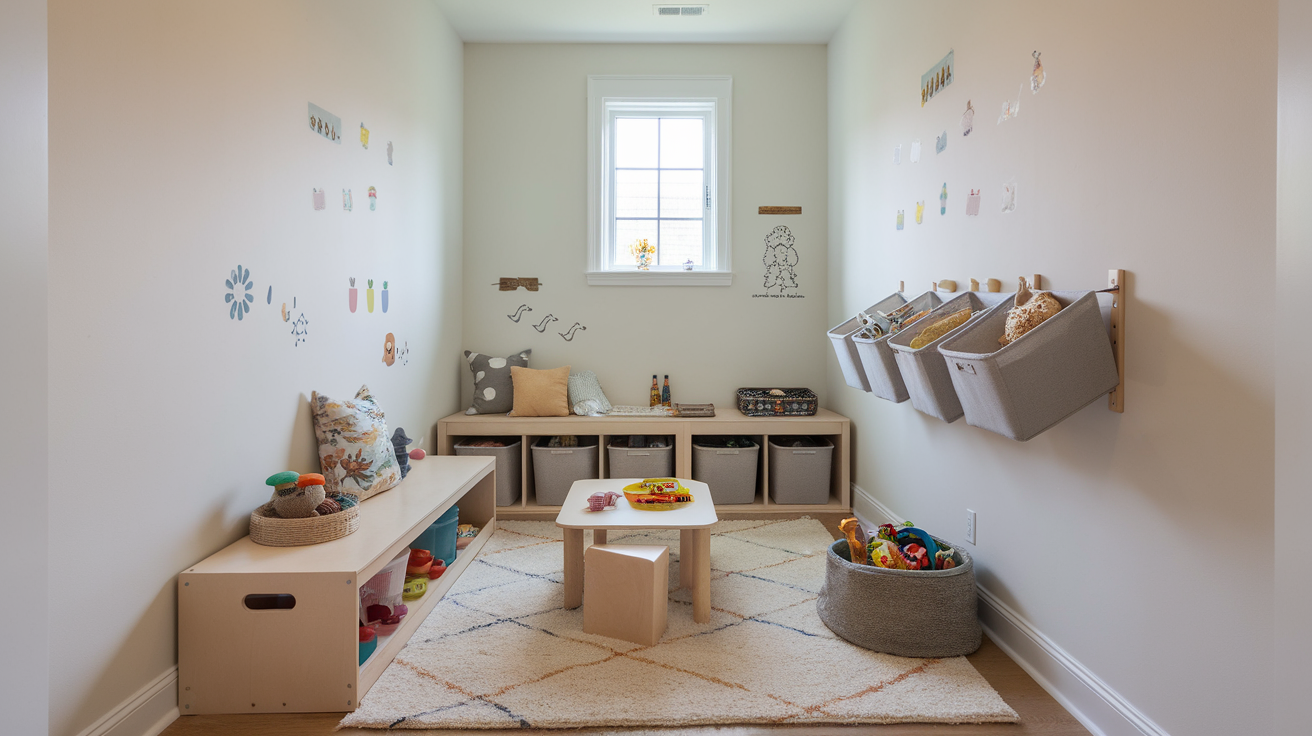Creating a playroom in a small space might seem challenging, but I’ve found that you don’t need a lot of room to make it work.
All it takes is some practical thinking and a few clever ideas. I’ve gathered some smart and simple ways to turn even the smallest corner into a fun, functional play area.
From space-saving storage to versatile furniture and decor, these tips are easy to use and budget-friendly.
You and I can take any tight space and turn it into a joyful, organized place your child will truly enjoy.
Why a Small Playroom Matters
A small playroom might not seem like a big deal, but I’ve seen how it helps kids play more independently and creatively.
It gives them a space to be themselves, to read, build, or imagine, without needing constant direction. You don’t need four walls or fancy toys.
Even a play corner or converted closet can offer structure and comfort. It also helps keep the rest of your home a little calmer and more organized.
I think giving your child a space of their own, no matter the size, makes them feel seen, capable, and encouraged to learn through play.
Small Playroom Ideas
Below are some playroom ideas which will make use of all the space you have:
1. Vertical Storage
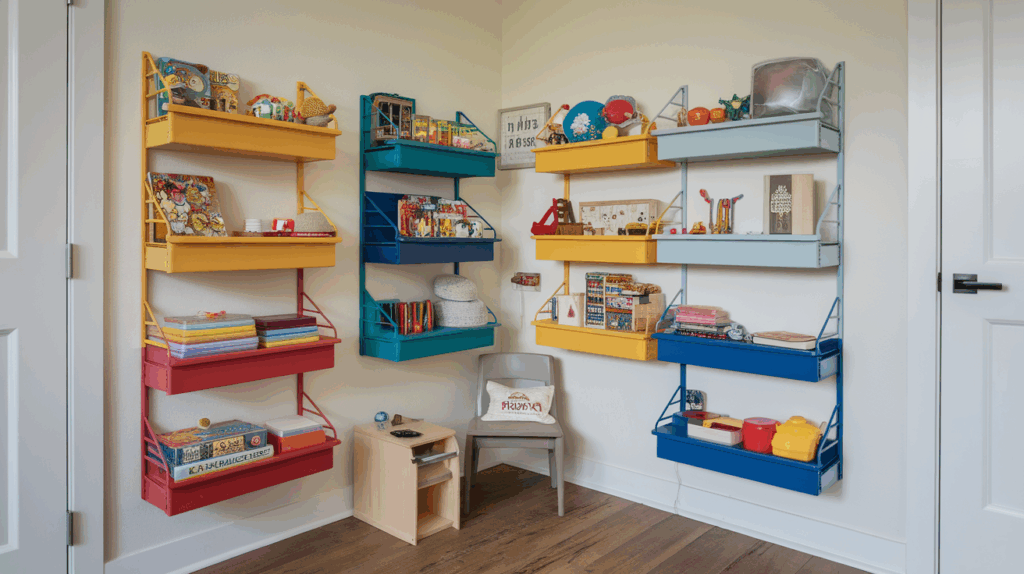
Vertical storage is a fantastic way to make use of limited space in your playroom. By using shelves, hooks, or tall cabinets, you can store toys and books out of the way, keeping the floor clear for more playtime.
It’s a practical solution that doesn’t eat up valuable space and can be customized to fit the room’s design.
Vertical storage helps organize toys and materials while leaving plenty of room for play.
2. Storage Ottoman Seating
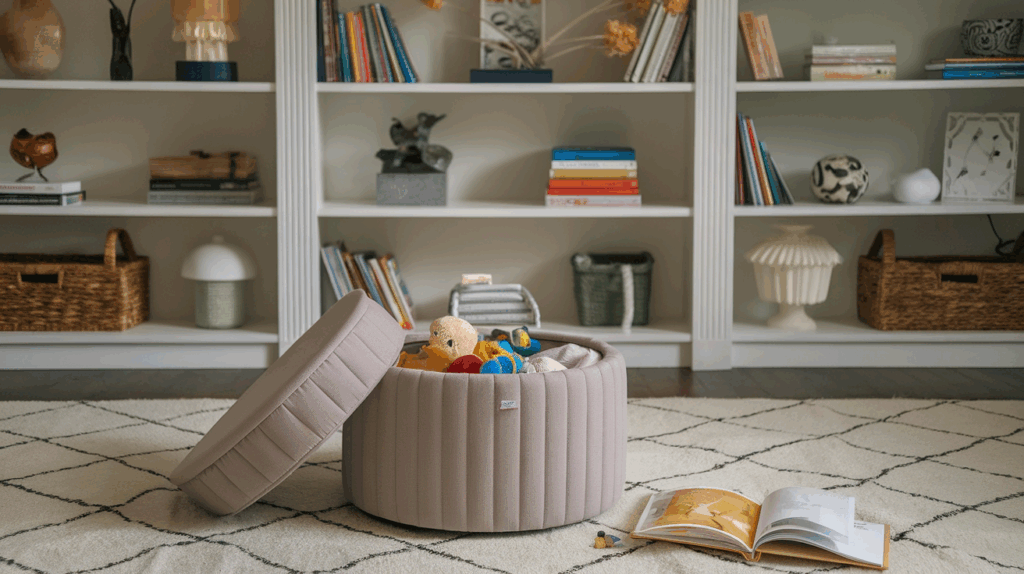
A storage ottoman serves as both seating and hidden storage, making it an ideal choice for compact playrooms.
These versatile pieces allow for easy access to toys, books, or even craft supplies, all while doubling as comfortable seating.
Storage ottomans come in various sizes and styles, so they can easily blend into your decor while helping you keep the playroom organized and functional.
3. Foldable Tables
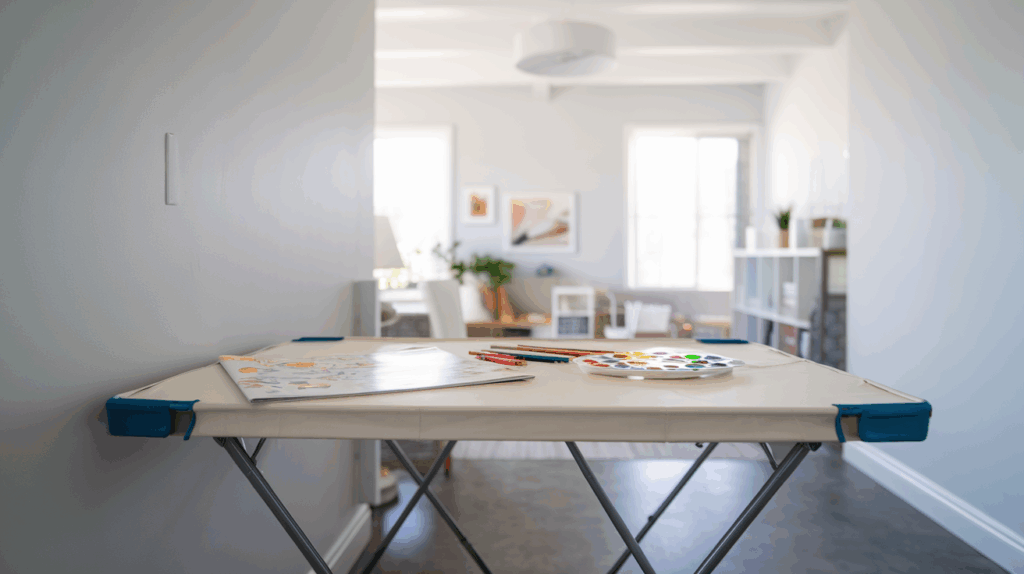
Foldable tables are great for creating extra workspace without sacrificing storage.
These tables can be folded away when not in use, which frees up room for more activities. Ideal for craft time, snack breaks, or homework, foldable tables make it easy to create a functional area that you can quickly store when space is needed for play.
These tables are often lightweight and easy to move, making them an ideal solution for families that need flexible playroom setups without taking up permanent space.
4. Stackable Bins
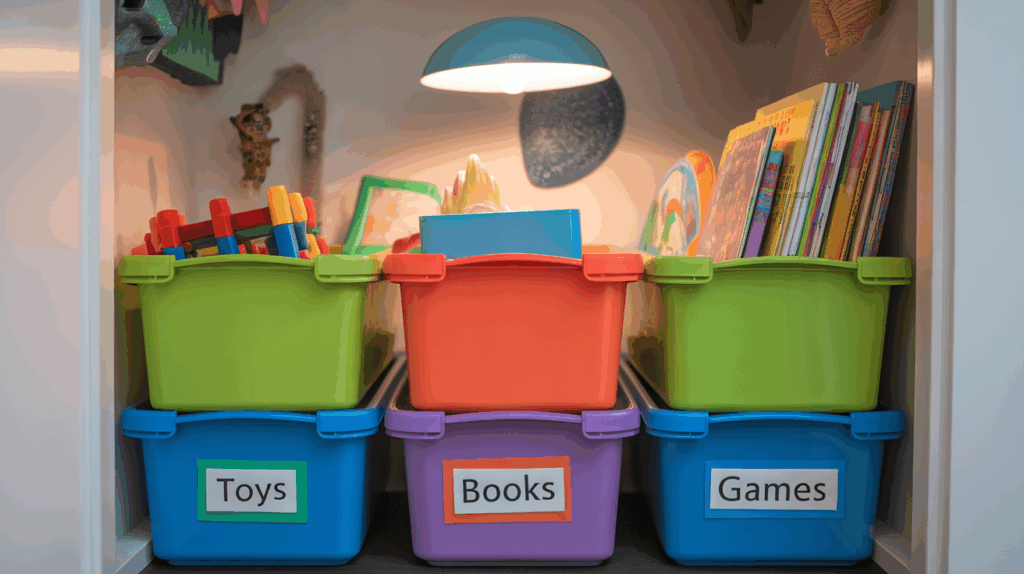
Stackable bins are perfect for storing toys, arts and crafts materials, or books. They come in different sizes, so you can stack them neatly to fit your available space.
These bins make it easy to organize toys and keep everything within reach without making a mess.
Their clear plastic design allows children to quickly identify what’s inside, promoting easy access and encouraging them to clean up after themselves.
Stackable bins help maintain a tidy environment and can be arranged to maximize vertical storage in tight corners.
5. Play Tent or Fort
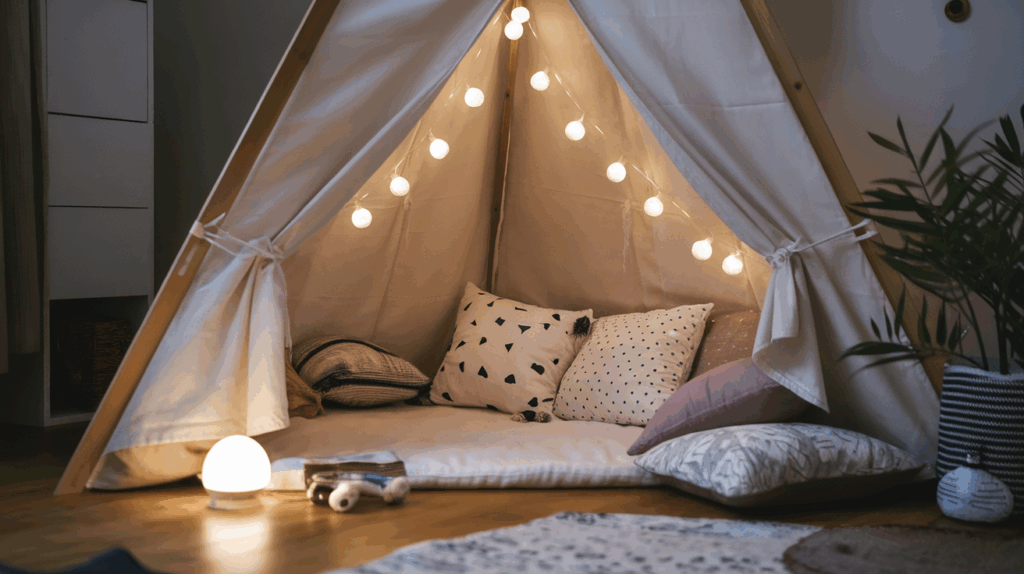
A play tent or fort can instantly transform your child’s playroom into an imaginative haven. Not only does it provide a cozy nook for reading or playing, but it also offers extra storage space for toys or games.
When playtime is over, the tent can easily be packed up and tucked away, making it an incredibly space-efficient option.
Play tents come in various sizes and themes, so you can create a fun and functional space that aligns with your child’s interests while keeping the room organized and playful.
6. Pegboard Organization
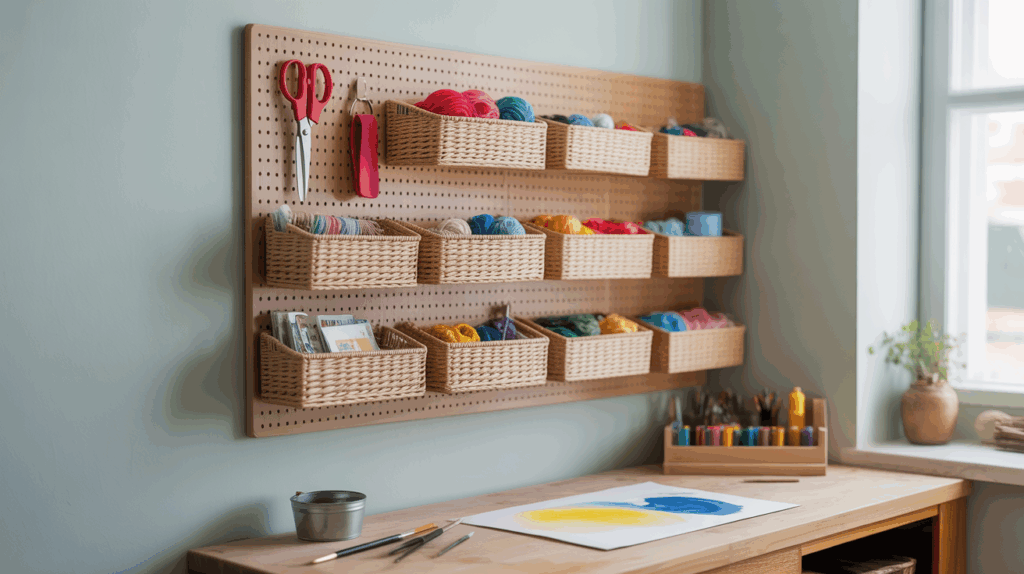
A pegboard offers flexible, customizable storage for your child’s art supplies, toys, and small accessories. You can add hooks, baskets, and shelves to organize items neatly and access them easily.
This wall-mounted option saves space by using vertical space and makes it simple to switch out the items stored, adapting as your child’s needs change.
Pegboard organization is not only practical but also an easy way to create a visually engaging storage system that adds a touch of creativity to the room.
7. Closet Play Nook
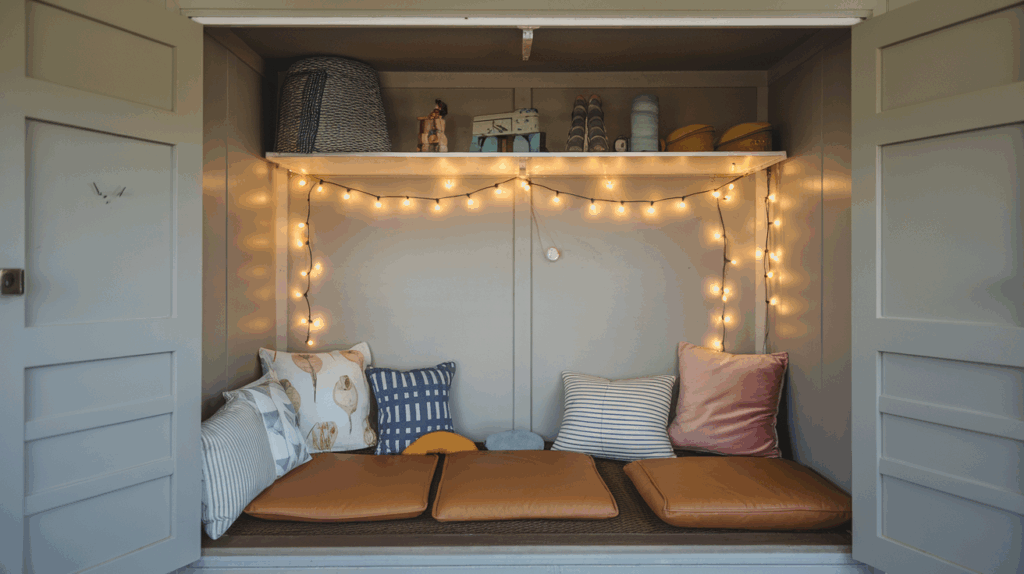
Turning a closet into a play nook is a clever way to maximize small spaces. With a few shelves, cushions, and storage bins, you can create a cozy hideaway for your child to play in.
It’s an affordable solution for organizing toys while giving your child a dedicated space to escape into their imagination.
The closet play nook makes use of otherwise wasted space, providing both a functional and imaginative environment where your child can engage in hours of creative play.
8. Chalkboard or Whiteboard Wall
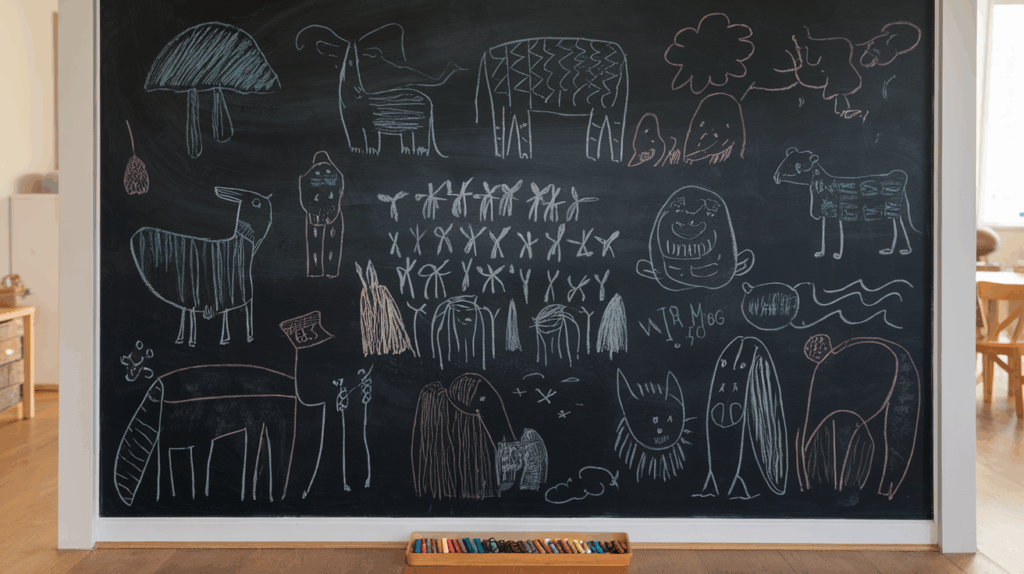
A chalkboard or whiteboard wall provides an interactive space for drawing, learning, or brainstorming. It encourages creativity while also serving as an organizational tool.
You can use it for jotting down reminders, tracking your child’s activities, or even planning out playtime schedules. This versatile wall space makes it fun to keep the playroom tidy while promoting active engagement.
It also offers an ever-changing canvas for your child to explore their artistic side and express their ideas freely.
9. Under-Bed Storage
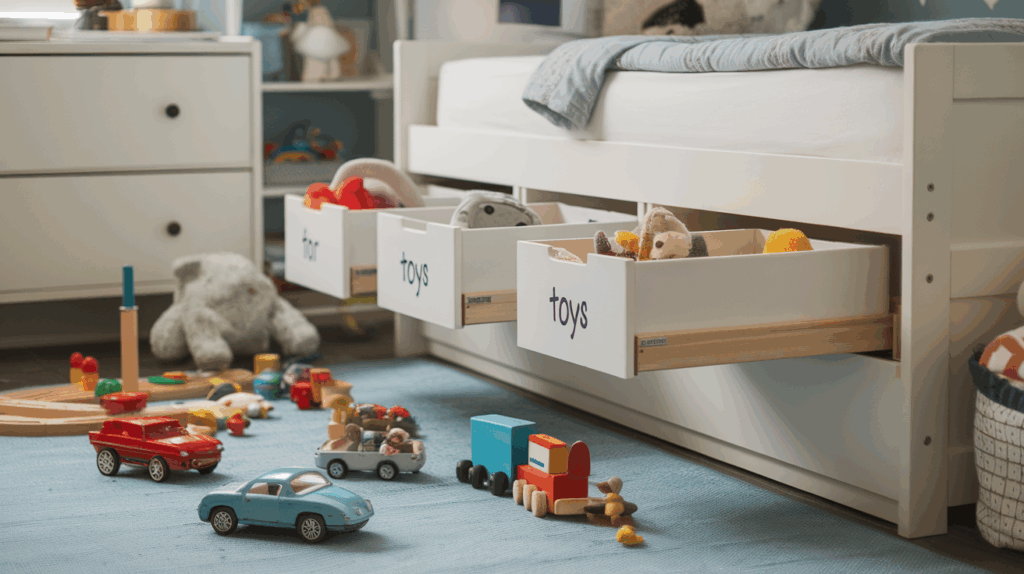
Under-bed storage is often overlooked but can be a game-changer when it comes to saving space. With bins, drawers, or storage boxes tucked neatly under the bed, you can store everything from stuffed animals to board games.
It’s an easy way to keep things organized and out of sight, giving the playroom a clean and clutter-free look.
Under-bed storage works especially well for small rooms, making use of the space you may not even think of, and can be a convenient solution to store seasonal toys or extra supplies.
10. Lofted Play Space
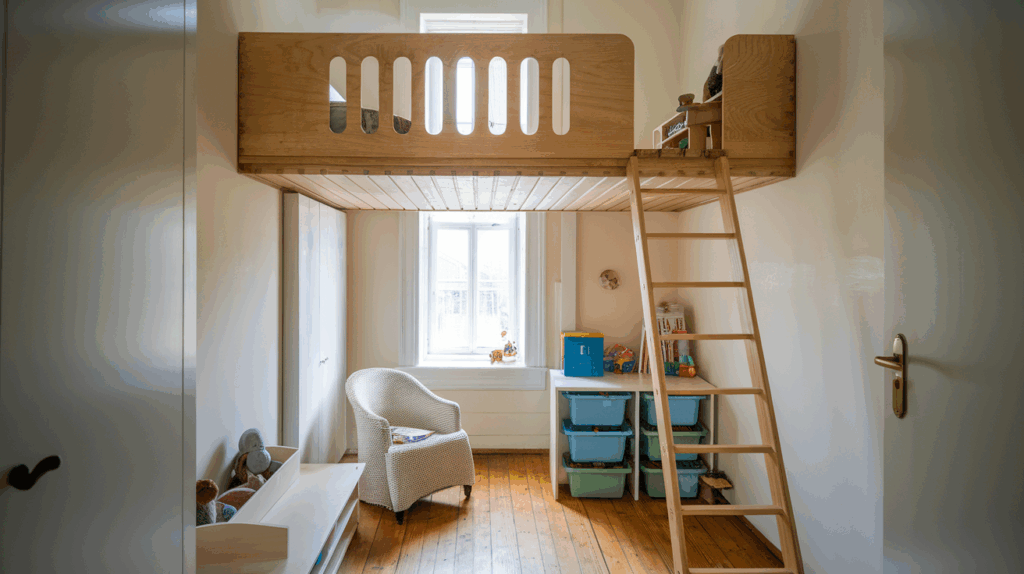
Lofted play spaces make use of vertical height, providing extra floor space underneath for other activities. By raising the play area, you can add shelves or storage below, creating a multi-functional room.
Lofted spaces also offer your child a unique play environment that feels separate and special, while still keeping things organized.
This approach allows you to maximize square footage while creating an elevated play area that your child will love, making it perfect for rooms with limited space.
11. Reading Nook with Cushions
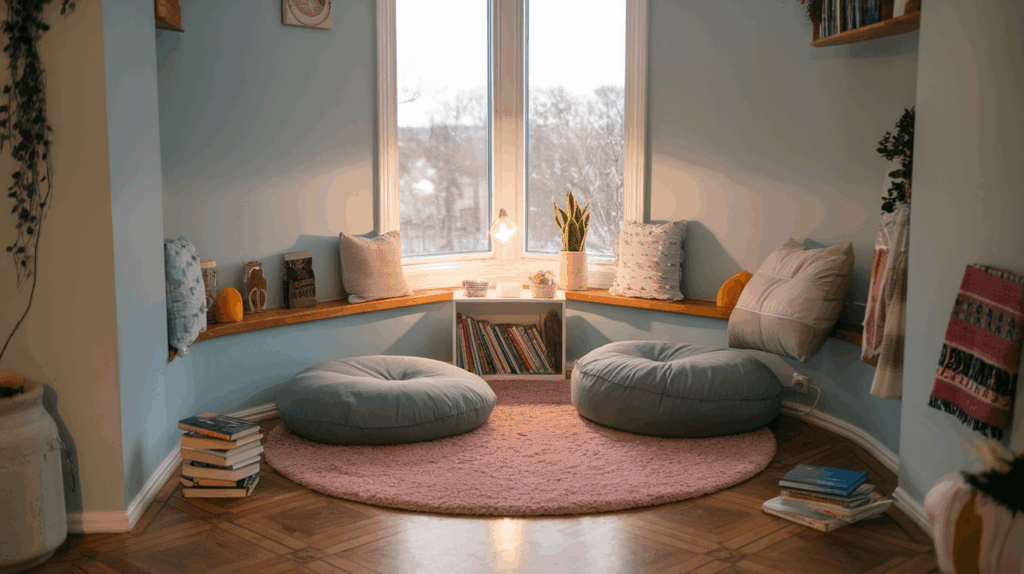
Create a cozy reading nook by adding cushions, bean bags, or a small chair to a corner of the room. This space encourages your child to unwind and read in a calm setting, while also providing storage for books and toys.
A reading nook adds a warm touch to your playroom while ensuring that books are stored neatly and within easy reach.
It can also double as a quiet area where your child can relax, fostering both creativity and tranquility in a fun and organized way.
12. Wall-Mounted Climbing Wall
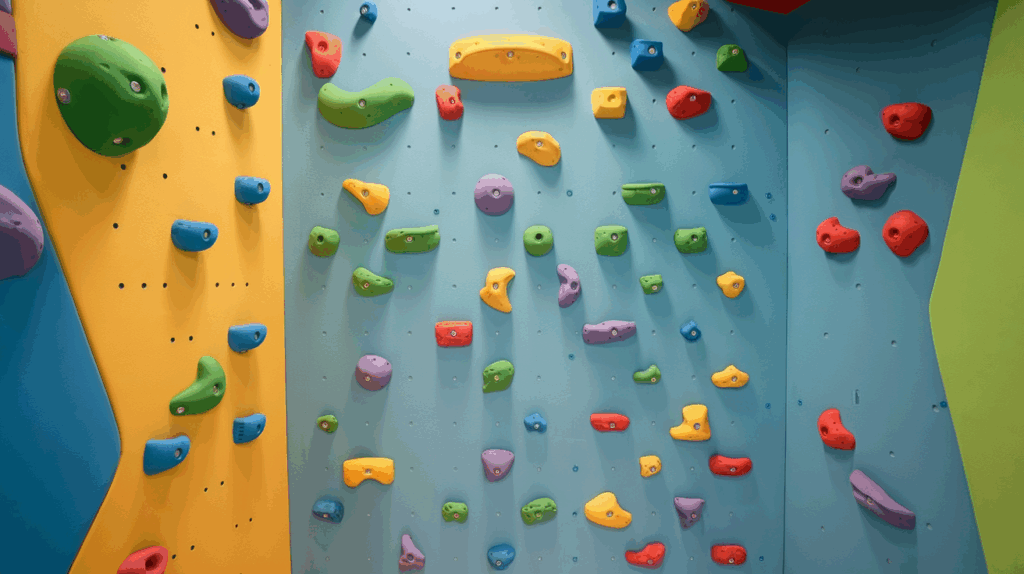
For active children, a wall-mounted climbing wall offers both physical exercise and fun.
By installing a climbing structure on one wall, you can turn any space into a mini adventure playground.
It helps keep toys and climbing equipment organized, providing your child with a safe, structured way to burn off energy.
A climbing wall not only promotes physical activity but also allows you to use wall space creatively, turning the playroom into an engaging, functional area for active play and development.
13. Toy Kitchen in Corner
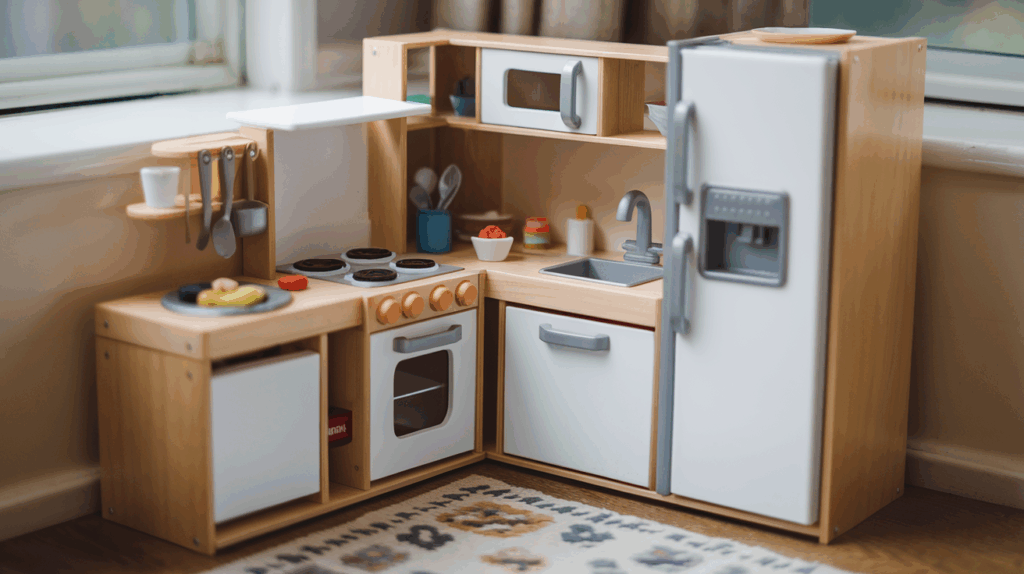
A toy kitchen in the corner of your playroom can be both fun and functional. It provides a designated space for cooking and roleplay, while also keeping your child’s toys neatly organized within the kitchen area.
The compact nature of toy kitchens means they take up minimal space, making them a perfect addition to any room.
With shelves or storage drawers integrated into the design, these kitchens can keep all the accessories organized while offering a space for your child to develop their creativity and social skills.
14. Coat-Rack Dress-Up Station
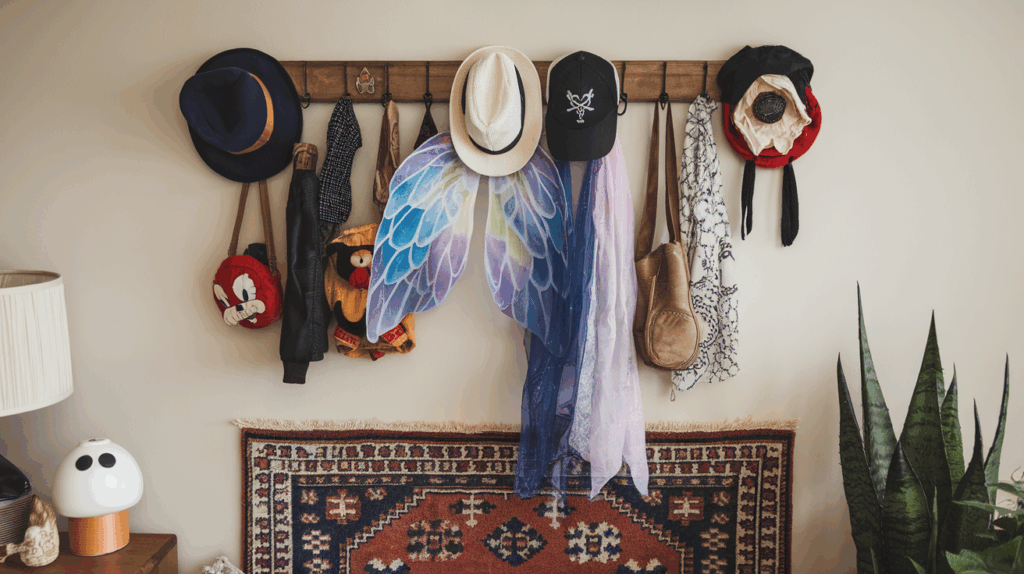
A coat-rack dress-up station helps organize costumes, hats, and accessories in an easy-to-access way.
This setup encourages imaginative play and helps teach children to clean up after themselves by hanging up their costumes.
With hooks and shelves, your child can store and display their favorite dress-up items without cluttering up the playroom.
A coat-rack dress-up station is an excellent way to keep costumes organized while promoting independence and creative play.
15. Floating Shelves for Books
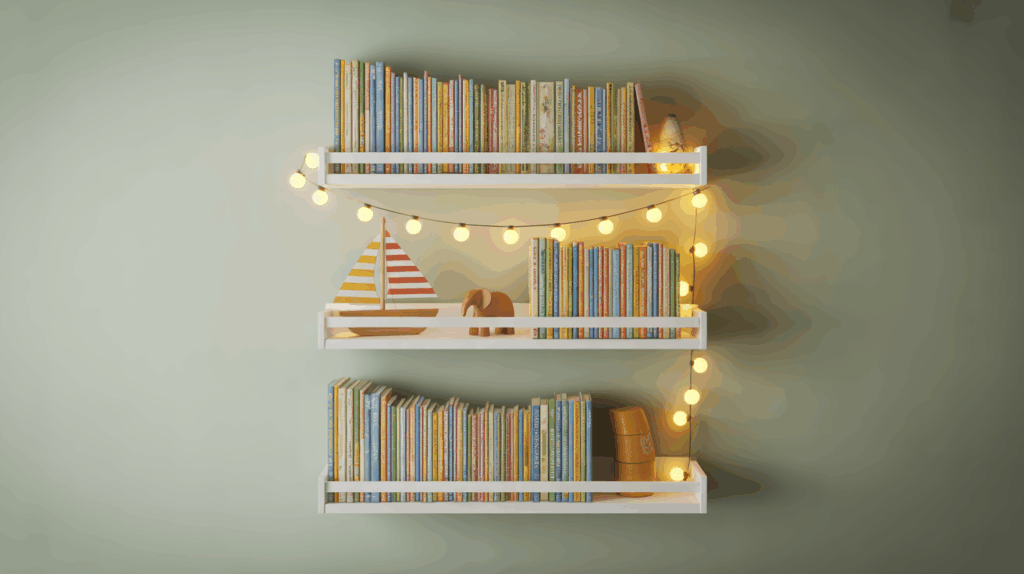
Floating shelves are a stylish and space-saving way to store books.
By mounting shelves on the wall, you can display your child’s favorite books without taking up valuable floor space.
These shelves keep books organized, easy to access, and visible, making it fun for your child to pick out their next story to read.
Floating shelves also allow you to organize books by theme, size, or favorite characters, making the room visually appealing and easy for your child to navigate.
16. Magnetic Board
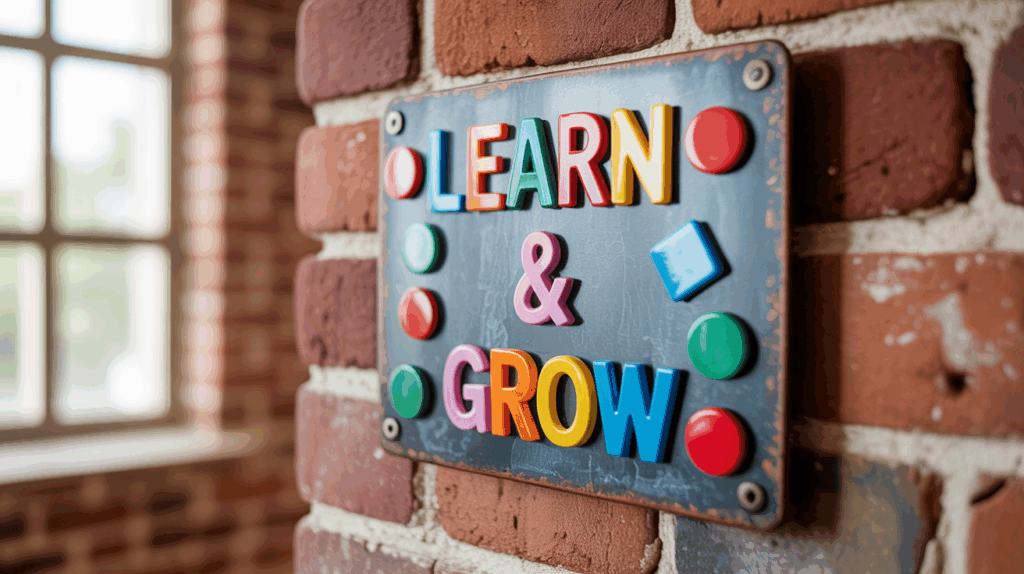
A magnetic board offers a functional space for displaying artwork, notes, or educational materials. It can also serve as a storage place for magnets, creating a colorful, interactive area.
Magnetic boards help keep your playroom tidy by providing a dedicated space for important items, while also sparking creativity and learning.
You can easily change the artwork or activities on display, making it a dynamic and engaging feature of your child’s play area.
17. Rolling Art Cart
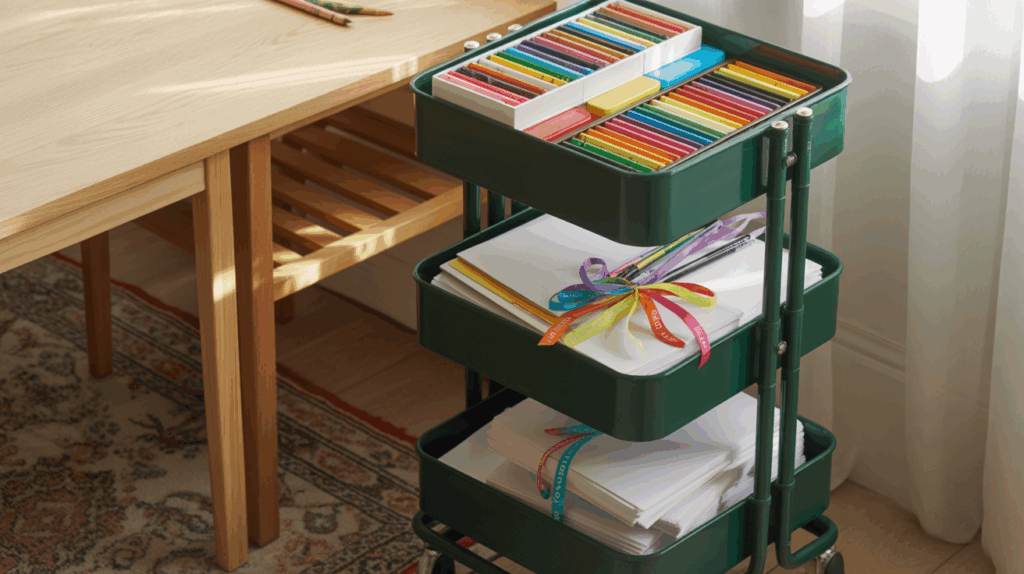
A rolling art cart is a great way to keep art supplies organized and accessible. It allows your child to roll the cart from room to room for crafting or other activities.
When playtime is over, simply roll it out of the way, keeping your playroom tidy and the art supplies stored securely.
This mobile cart helps teach children organization skills while providing a practical solution for keeping art supplies within easy reach but neatly out of sight when not in use.
18. Foldable Chairs
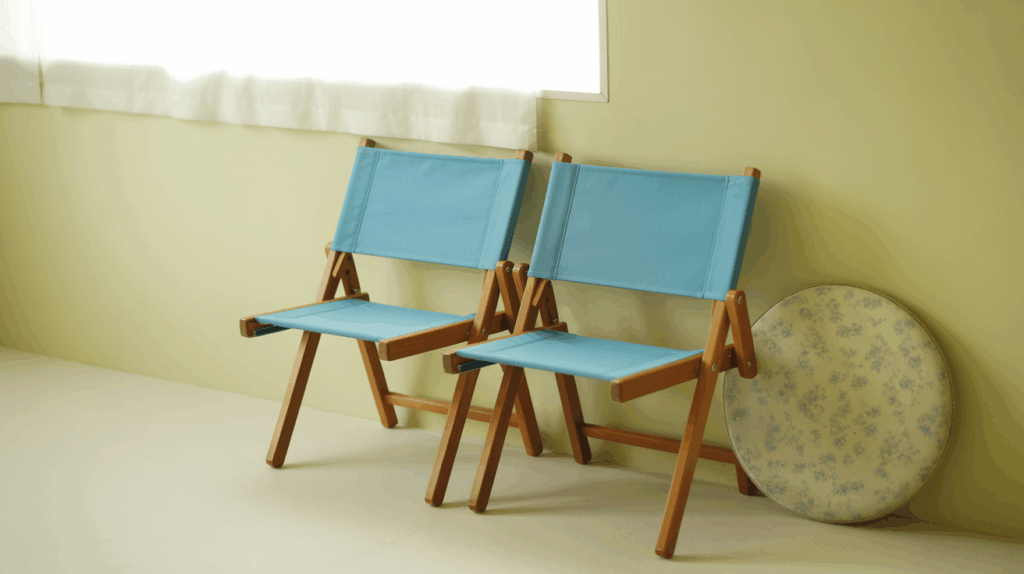
Foldable chairs provide flexible seating for your child’s playroom. When not in use, they can be folded up and stored in a closet or under a table, freeing up space for play.
These chairs are ideal for playdates or family gatherings, providing extra seating without taking up permanent room in the play area.
Foldable chairs are portable, lightweight, and versatile, making them an excellent choice for maximizing space in smaller rooms.
19. Area Rugs Define Zones
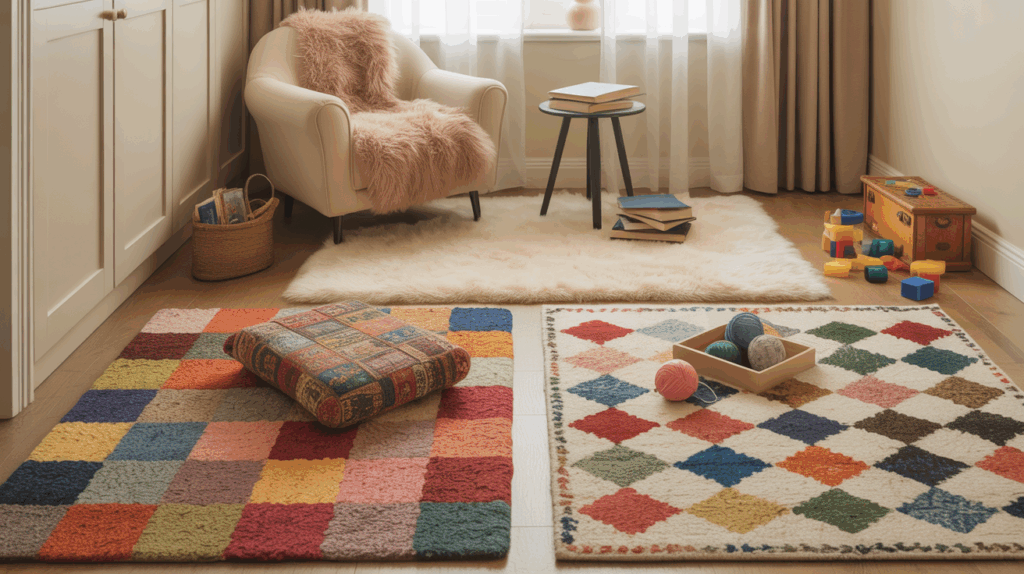
Area rugs can be used to define different zones in the playroom, such as a reading nook, art corner, or toy area. This helps organize the space, making it feel less cluttered and more structured.
Rugs also add warmth and comfort, creating a cozy atmosphere for playtime.
They help separate activity zones, allowing for a designated space for each type of play, keeping your child’s environment both organized and inviting.
20. Under-Stairs Play Space
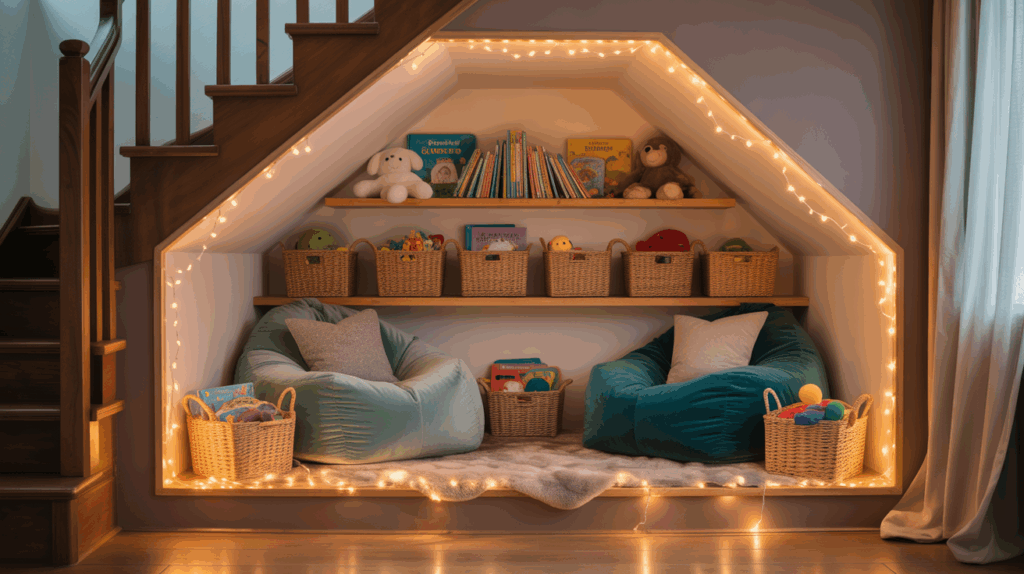
If you have stairs in your home, consider converting the space underneath into a play area. This often-unused space can be transformed into a cozy nook for storing toys or setting up a small playhouse.
It’s an affordable way to maximize space while creating a fun, functional play area for your child.
The under-stairs area can also be used to hide clutter, giving the playroom a clean, organized look while providing your child with a unique space to play.
21. Built-in Shelves
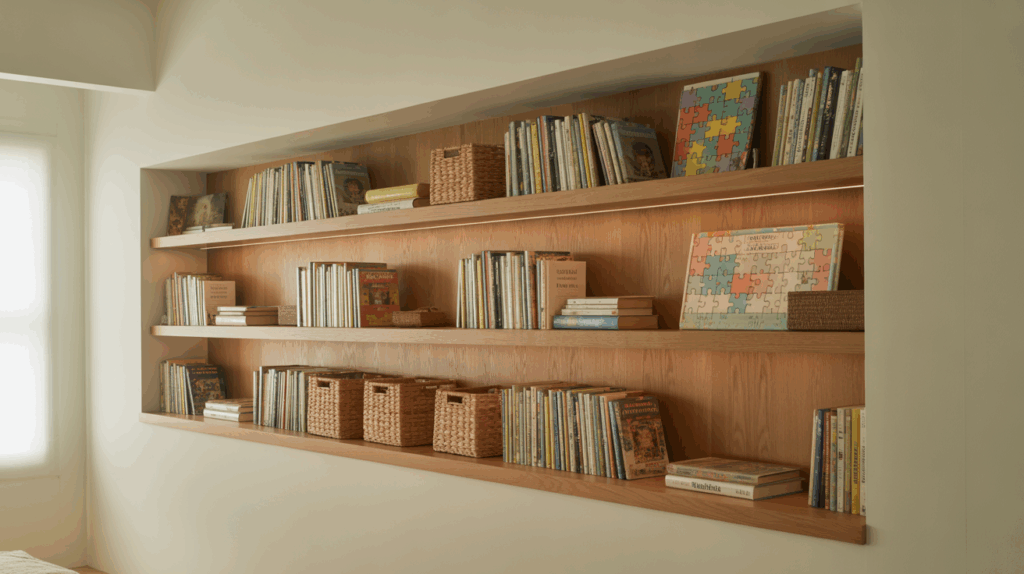
Built-in shelves are a fantastic solution for maximizing storage space in your playroom. By installing shelves directly into the walls, you can keep the floor clear and provide designated storage areas for books, toys, or art supplies.
These shelves are customizable to your needs, allowing you to store everything neatly in place.
Built-in shelves create a clean, streamlined look and keep your child’s toys accessible but organized, providing both functionality and visual appeal in the room.
22. Foam Floor Tiles
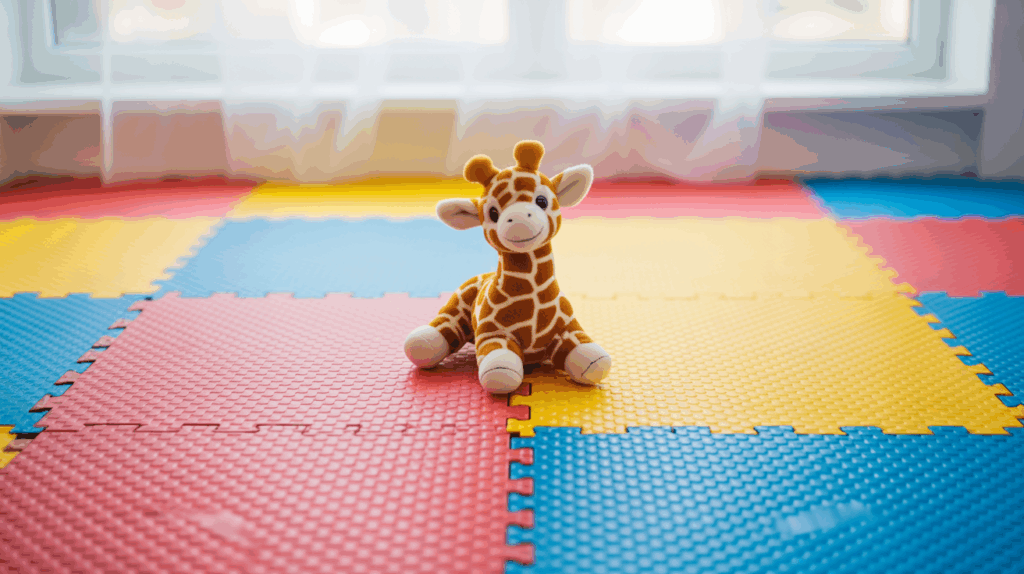
Foam floor tiles create a soft, comfortable surface for children to play on. They come in various colors and patterns, adding a fun, customizable touch to the playroom.
Additionally, they are non-slip and easy to clean, making them a safe option for kids.
Foam floor tiles can be quickly rearranged or removed if needed, giving you the flexibility to adjust the layout of the playroom as your needs change.
This option is great for creating a cushioned play area that’s both practical and visually engaging.
23. Peg-Labeled Bins
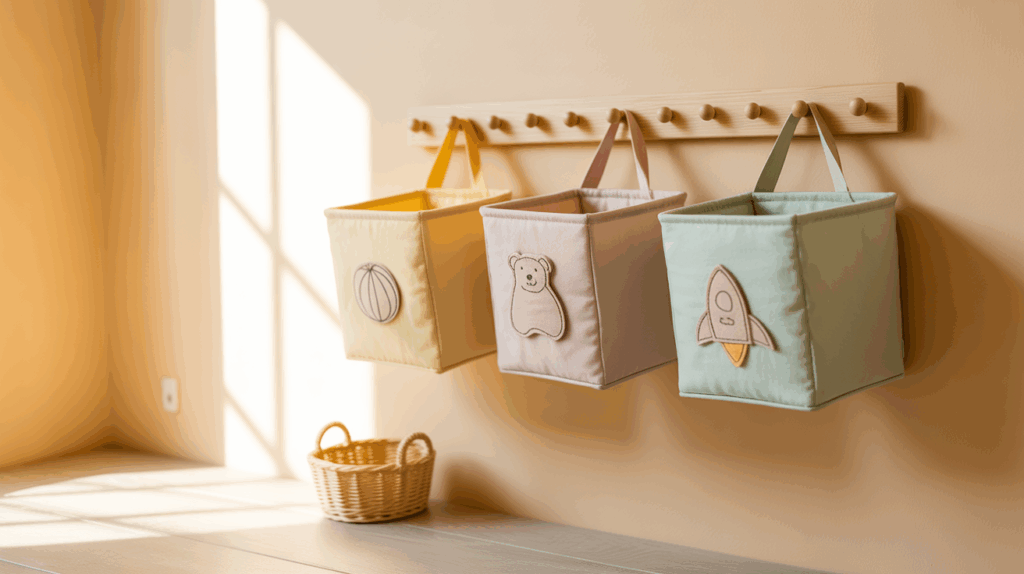
Peg-labeled bins are a great way to keep toys organized and easy to find. These bins can be hung on a pegboard or placed on shelves and labeled with clear tags.
The labeling system makes it easy for your child to clean up after playtime, promoting organization and tidiness in the playroom.
Peg-labeled bins are versatile, as you can adjust the labels as your child’s collection of toys changes, ensuring that everything stays in its place and is easy to access when needed.
24. Toy Rotation System
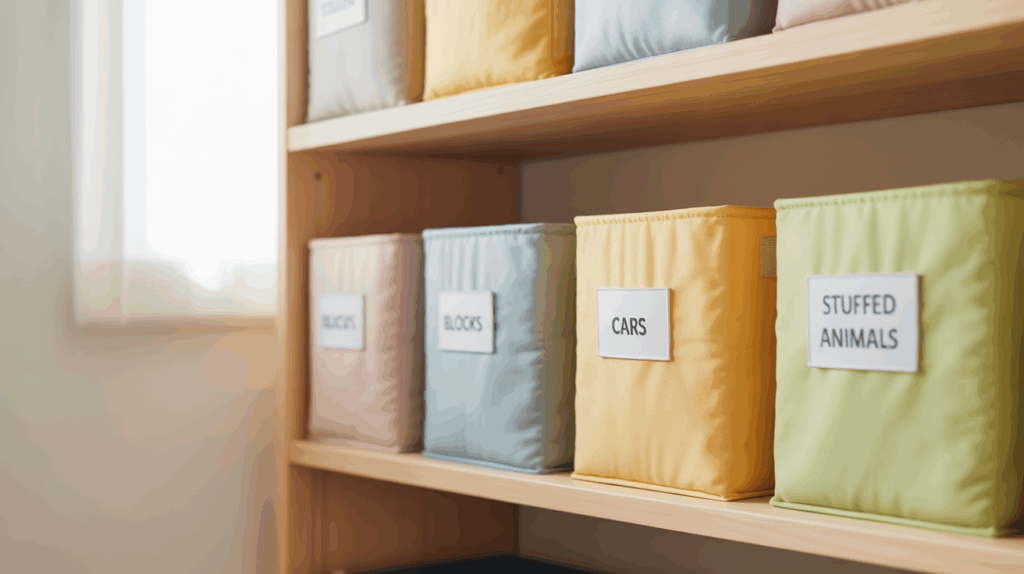
A toy rotation system helps keep your child’s play area fresh and organized. By rotating toys in and out of storage, you can keep the room clutter-free while maintaining your child’s interest in different toys.
This system prevents overwhelming your child with too many choices at once, helping them focus on one activity at a time.
Toy rotation also gives you the chance to rediscover forgotten toys and maintain an engaging environment while ensuring that your playroom stays neat and tidy.
25. Personalized Gallery Wall
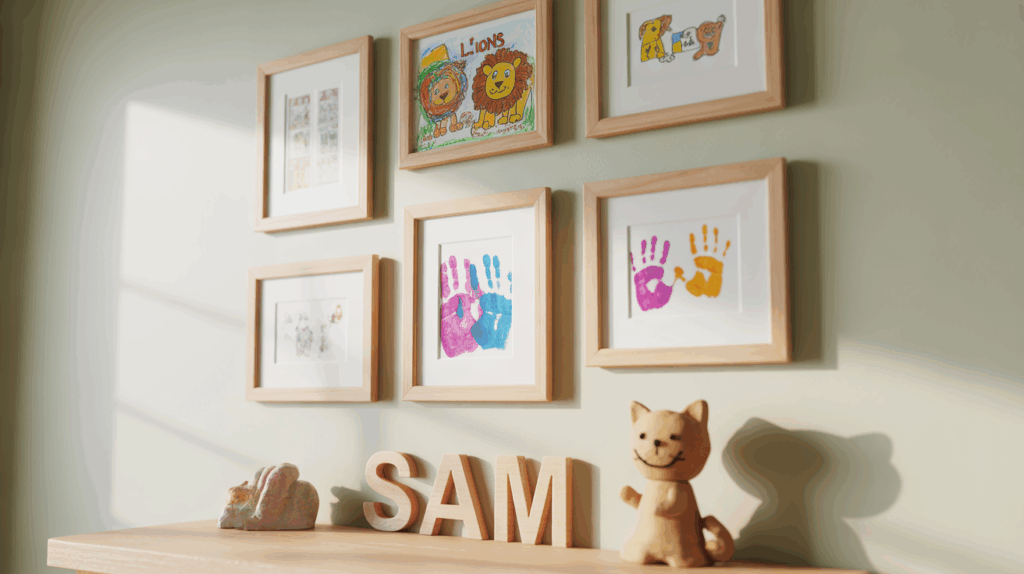
A personalized gallery wall adds a personal touch to your child’s playroom.
Displaying their artwork, photographs, or favorite quotes on the wall creates a unique and inspiring space.
It also helps keep the playroom organized by providing a designated area for displaying and rotating their creative expressions.
A personalized gallery wall offers an opportunity for your child to take pride in their work, while also turning the room into a colorful and motivating environment that encourages creativity.
26. Slide-Out Storage
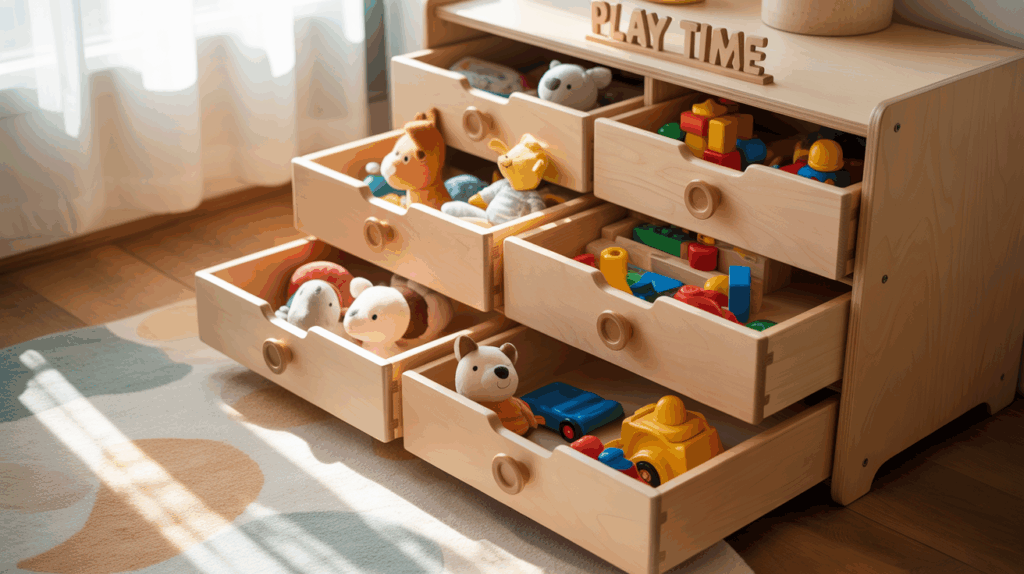
Slide-out storage units are perfect for keeping things hidden yet accessible. These units can slide out from under furniture or shelves, providing convenient access to toys, art supplies, or books.
They maximize space and help keep items organized while maintaining a clean, clutter-free environment.
Slide-out storage also helps you use underutilized spaces, such as under tables or cabinets, to store items neatly, making the playroom look tidy while offering functional storage solutions.
27. Convert Loft Into Play Area
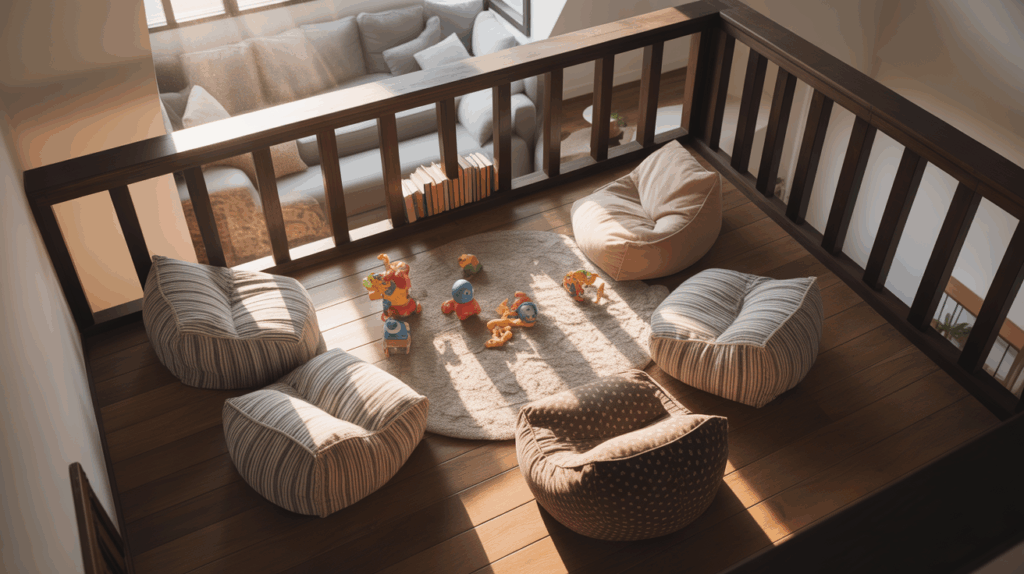
Converting a loft into a play area makes excellent use of vertical space. By setting up furniture, shelves, and storage in the loft, you can create a dedicated play zone that’s separate from the rest of the home.
This transformation adds more space to your home and provides a fun, unique area for your child to play and store their belongings.
Lofted spaces can also be a great hideaway for older kids, offering them a retreat where they can engage in creative activities away from distractions.
28. Transparent Toy Boxes
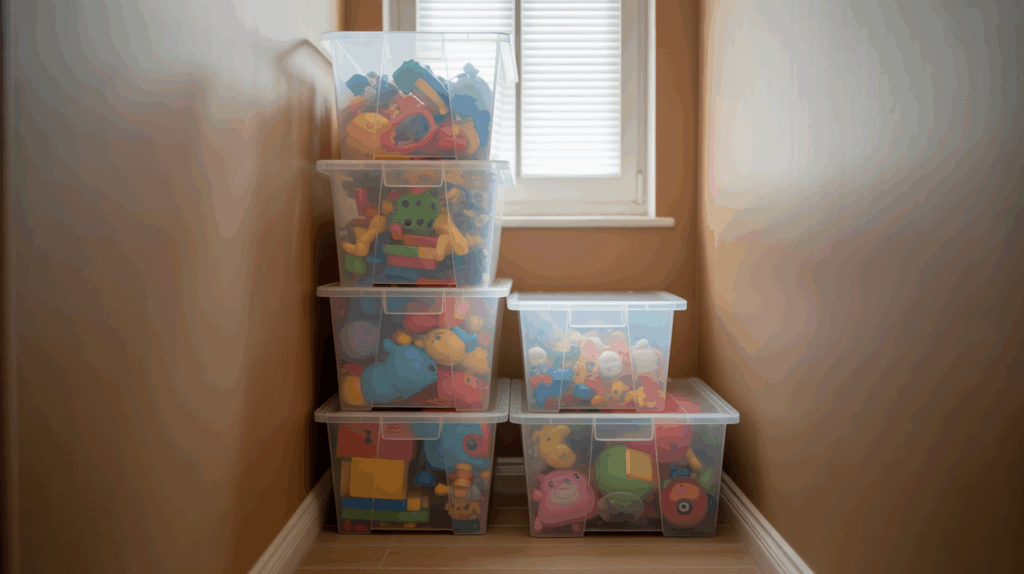
Transparent toy boxes make it easy for your child to find what they need without digging through a pile of toys. The clear design allows them to see exactly what’s inside, helping them stay organized and reducing clutter.
These boxes can be stacked or stored on shelves, making them versatile and functional for any playroom.
Transparent toy boxes also encourage your child to clean up on their own, as they can easily identify where things belong, fostering a sense of responsibility.
29. Woven Baskets
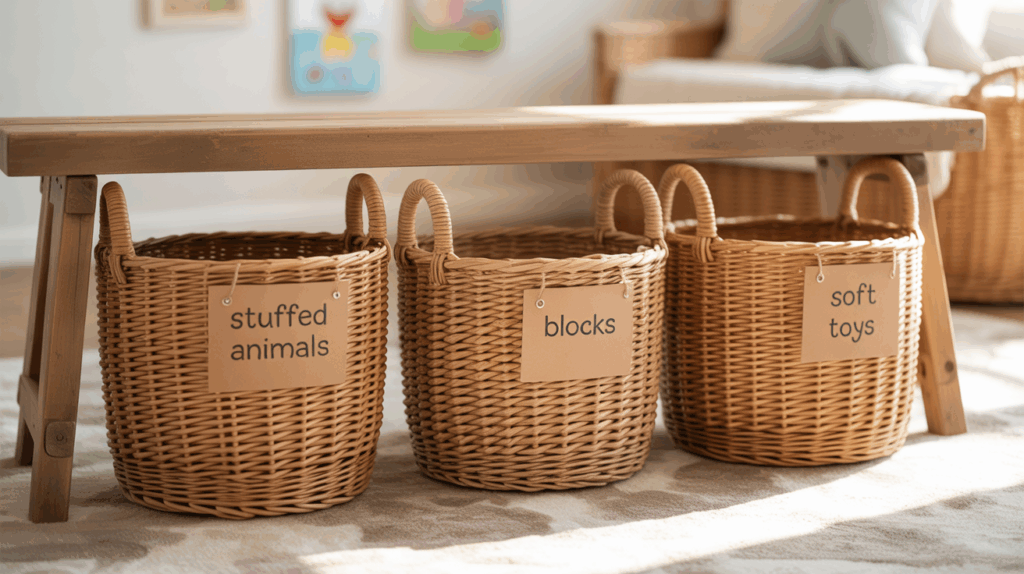
Woven baskets are both functional and stylish. They are perfect for storing toys, blankets, or art supplies and add a natural texture to your playroom.
With their sturdy design and aesthetic appeal, woven baskets can be placed in any corner or on shelves to keep things organized and easy to access.
These baskets provide a flexible storage solution that can be used to store a variety of items, while also contributing to the overall décor of the room.
30. Rotating Wall Display
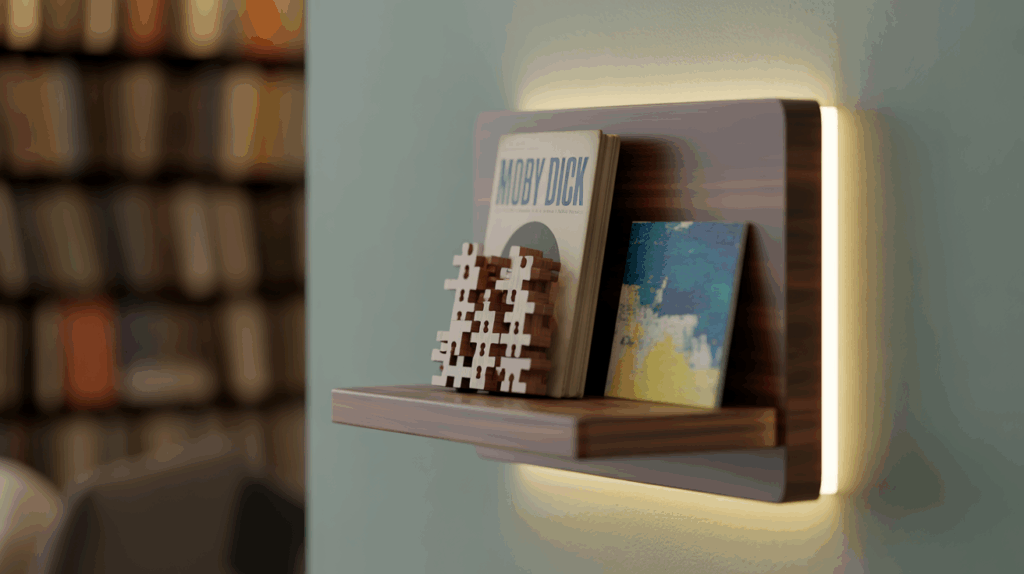
A rotating wall display allows you to showcase your child’s artwork, photos, or memorabilia in a dynamic way. This rotating system keeps the display fresh by allowing easy changes, so the playroom always feels new and organized.
It’s a creative solution to keep the space tidy while giving your child a fun way to display their creativity.
The rotating design also adds an element of fun and surprise, as they get to choose what’s displayed next, making it a great way to encourage self-expression..
31. Interactive Wall Games
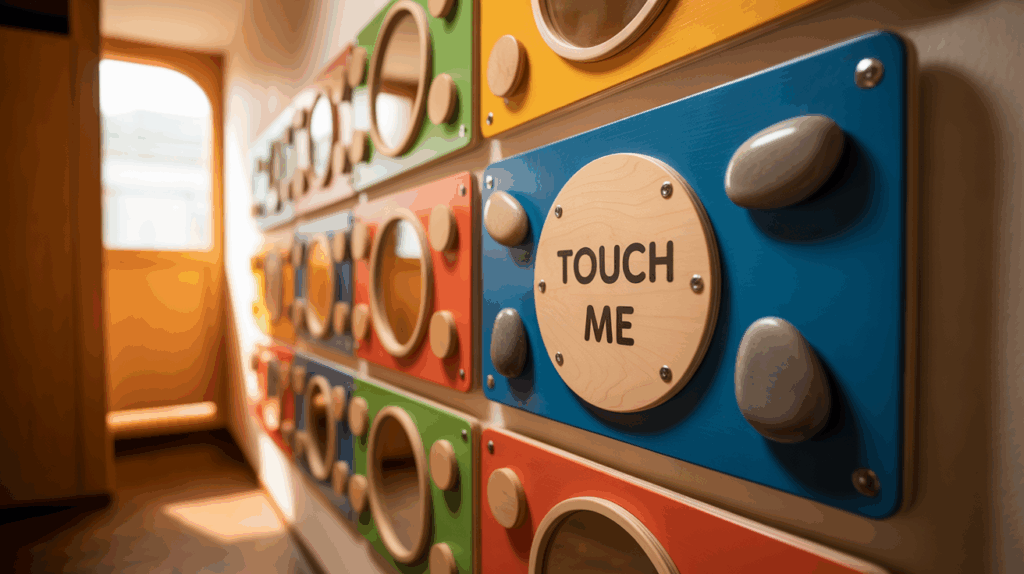
Interactive wall games bring a fun and educational element to the playroom. These wall-mounted games help develop fine motor skills, cognitive abilities, and problem-solving while keeping the play area organized.
By incorporating these games into your design, you can create an engaging and clutter-free space for your child to play and learn.
Interactive wall games also help keep your child entertained for long periods, reducing the need for additional toys and maintaining a neat environment.
32. Mirror to Boost Light
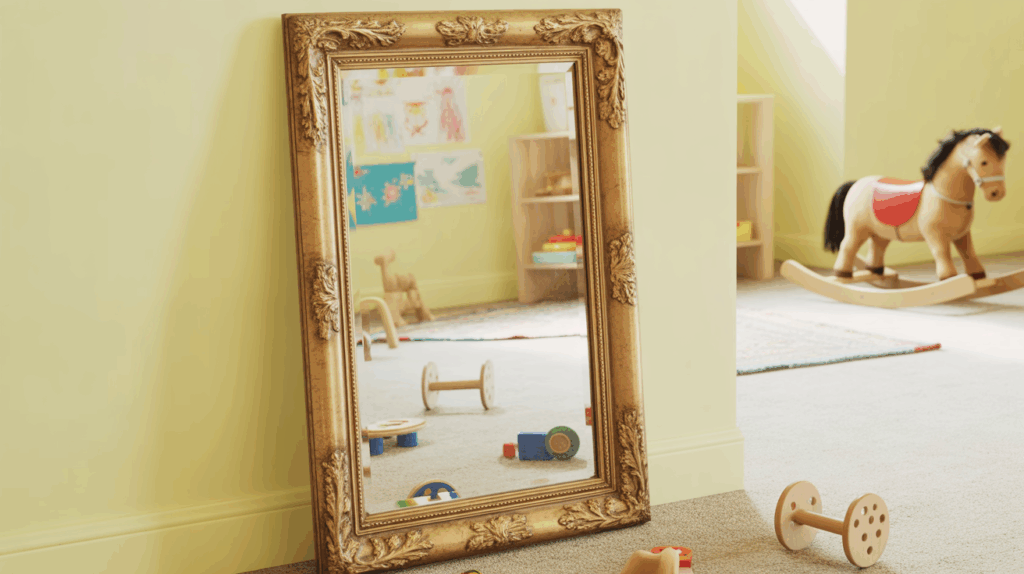
Adding a mirror to the playroom can help reflect light, making the space feel brighter and larger. It also creates a fun, interactive element for your child.
A mirror is a simple yet effective way to maximize space and light, ensuring the playroom feels more open and inviting.
Mirrors can be placed on walls or used as decorative elements, and they help create a lively, well-lit area for your child to play, learn, and grow.
33. Theme with Decals
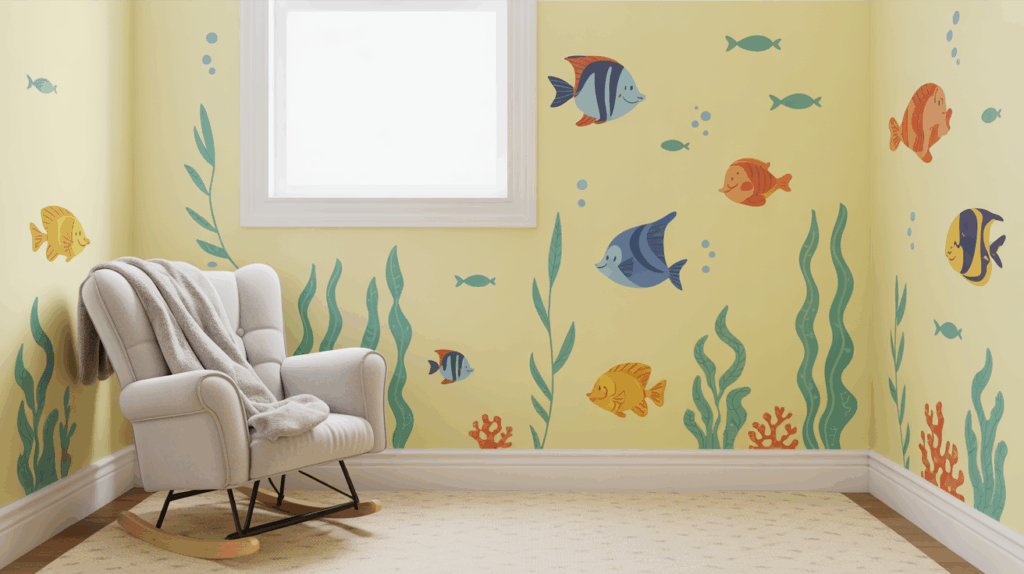
Using themed decals is a great way to add personality to your child’s playroom without overwhelming the space. Decals are easy to apply, remove, and replace, allowing you to change the room’s look as your child grows.
This creative and flexible solution helps keep the room fun, colorful, and organized.
Decals can also serve as educational tools, with designs that teach your child about animals, shapes, numbers, or letters, making the room both playful and functional.
34. Multi-Use Activity Table
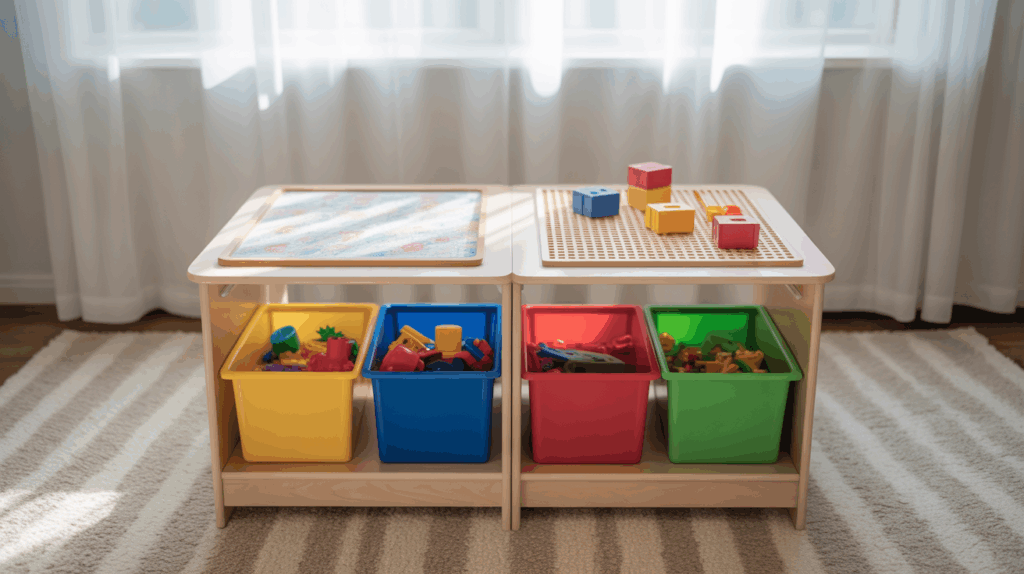
A multi-use activity table provides a dedicated space for your child to play, draw, and learn. It can be easily adapted for different activities, from arts and crafts to snack time.
This functional table helps keep the playroom organized by offering a central area for creative and educational pursuits.
Multi-use tables often come with built-in storage or compartments for art supplies and toys, helping reduce clutter and keeping everything within easy reach.
35. Industrial Pipe Shelves
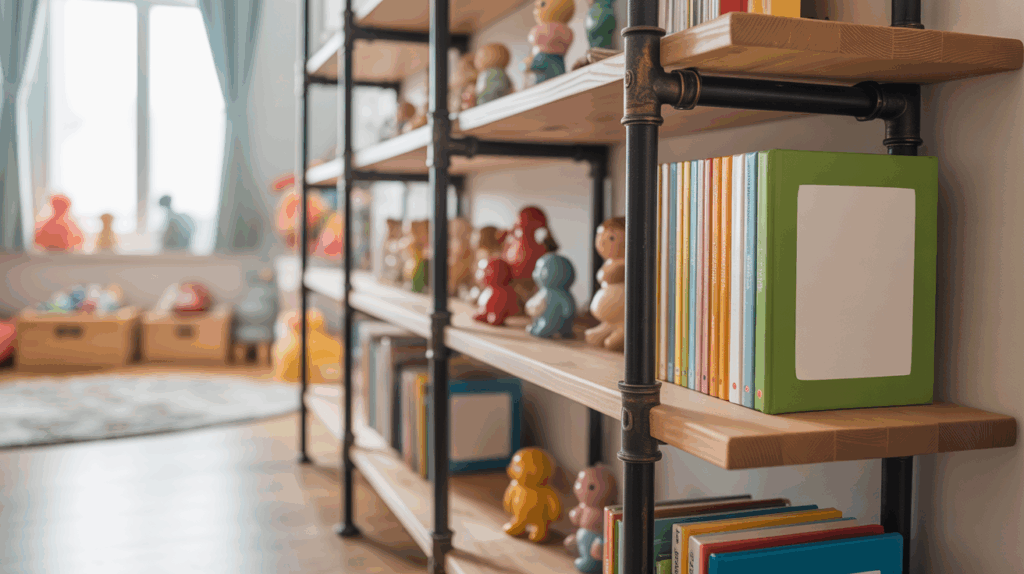
Industrial pipe shelves are both sturdy and stylish, offering a unique storage solution for your playroom.
They provide ample space for storing books, toys, and supplies while adding an industrial flair to the room.
These shelves are customizable and can be designed to fit your available space, keeping your playroom organized and chic.
With their open design, industrial pipe shelves allow easy access to stored items and can also be a fun way to display decorations or personal items.
36. Neutral Palette with Pops
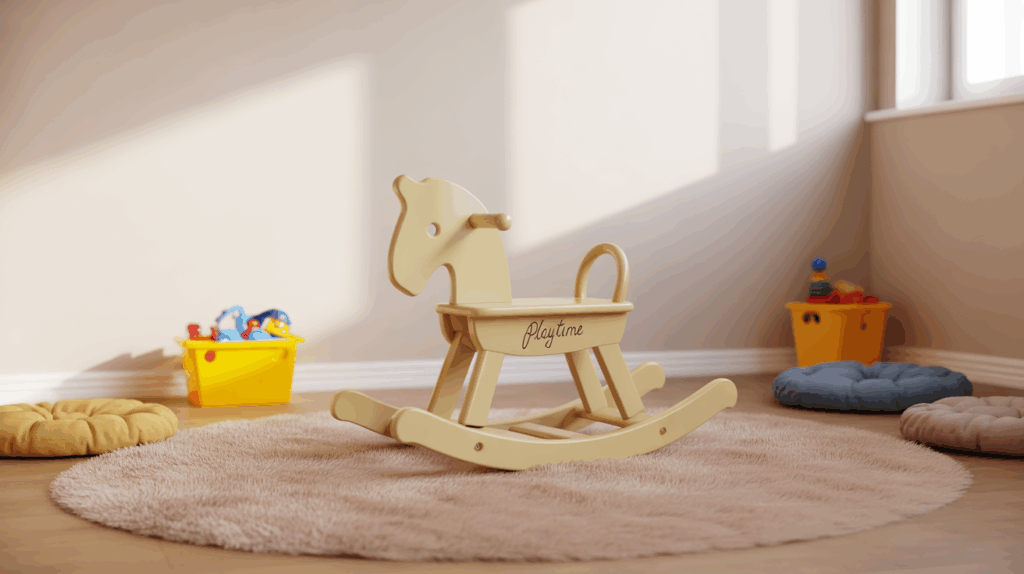
A neutral palette with pops of color creates a calming environment while allowing for playful accents.
Using neutral tones for furniture and walls, with colorful rugs or accessories, creates a balanced space that can grow with your child.
This approach keeps the playroom organized and fun without overwhelming the space.
The neutral tones provide a calming backdrop, while the pops of color can be changed as your child’s tastes evolve, keeping the room dynamic and easy to maintain.
37. DIY Rock Wall Panel
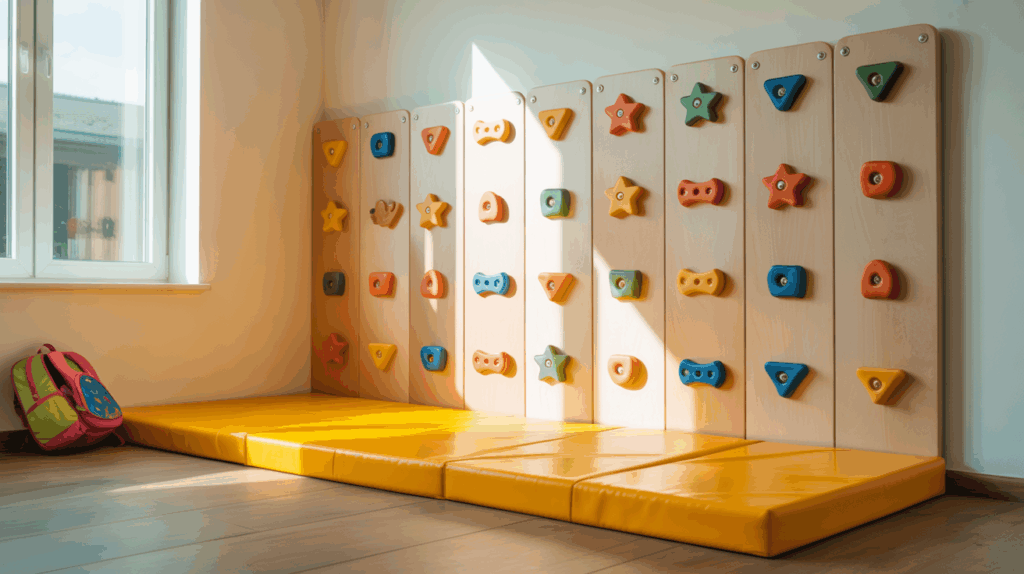
A DIY rock wall panel offers a unique way to incorporate active play into your child’s space. Not only does it keep them engaged physically, but it also serves as a great storage solution when paired with shelves or bins nearby.
This customizable feature allows you to create a space that’s both functional and exciting.
A rock wall panel not only adds a fun, challenging element to the room but also keeps the space organized by providing built-in storage options.
38. Hanging Chair or Swing
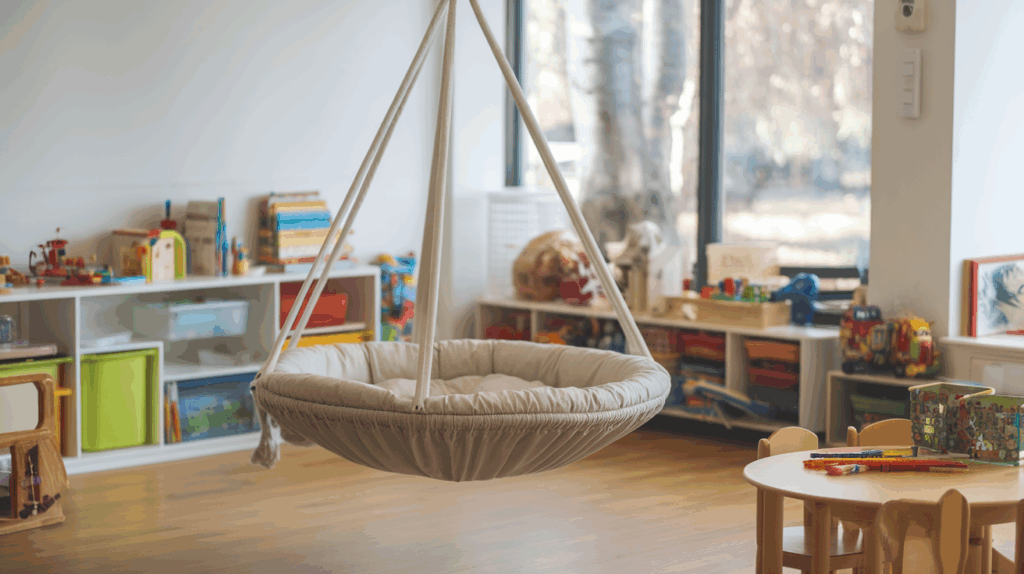
A hanging chair or swing adds a whimsical touch to your playroom while offering a cozy space to relax. It’s perfect for reading, swinging, or simply unwinding.
The hanging feature keeps it out of the way when not in use, helping to maintain an organized play area while providing a fun and relaxing spot for your child.
These chairs come in various styles, including soft cushions or hammock-like designs, to suit your room’s aesthetic and provide a comfortable retreat.
39. Foldable Playhouse
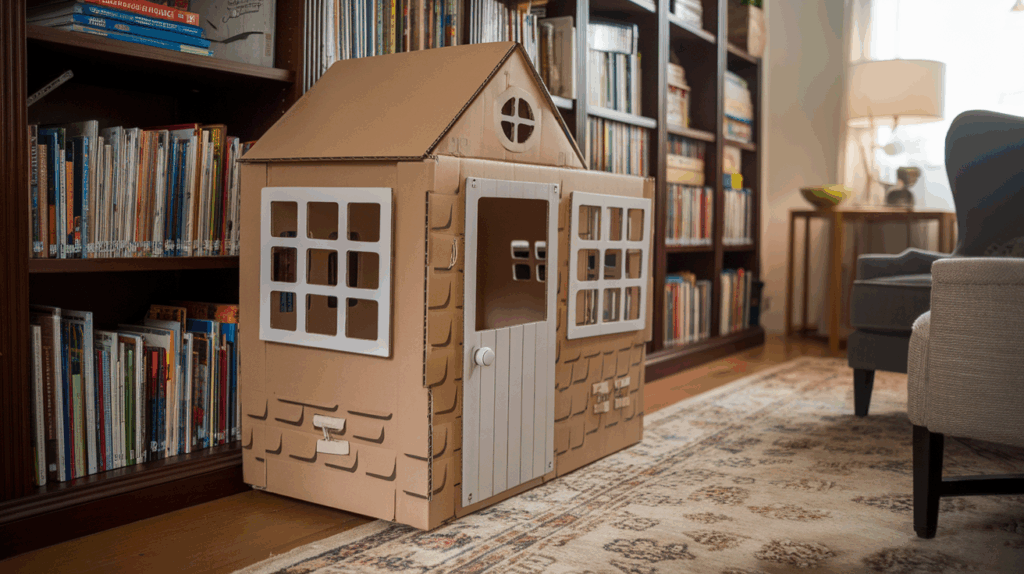
A foldable playhouse can be quickly set up and packed away, making it an ideal solution for tight spaces. It’s perfect for creating a temporary play area that doesn’t take up much room.
When folded, it can be stored in a closet or under the bed, keeping your child’s play area neat and clutter-free.
The playhouse is easy to transport, and its foldable design makes it a versatile option for parents who want to maintain flexibility in their space.
40. Chalkboard Tabletop
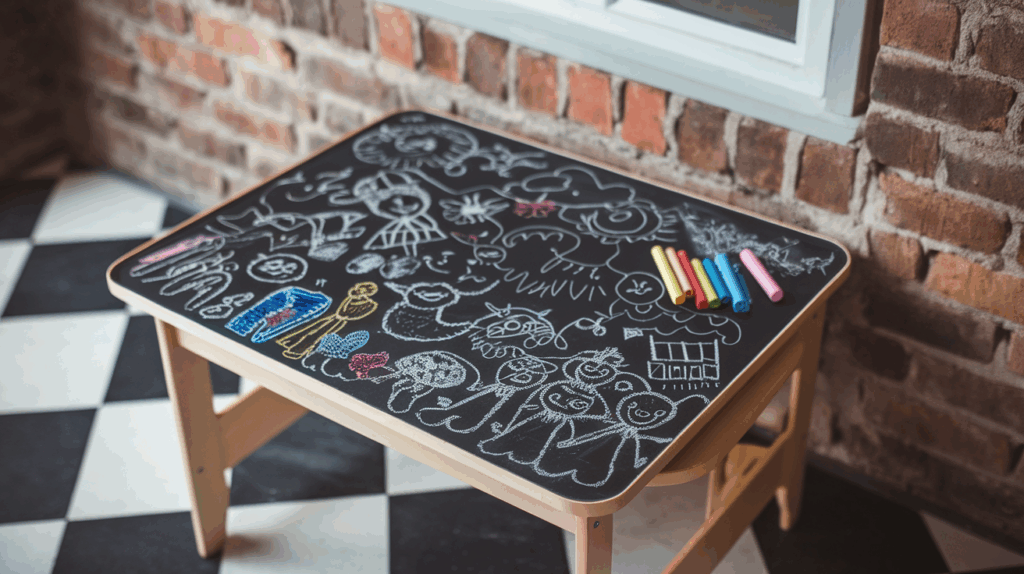
A chalkboard tabletop encourages creativity and learning while also providing a functional surface for activities. It’s easy to clean and can be used for drawing, writing, or even playing games.
This practical addition helps keep the playroom organized by offering a dedicated space for your child’s creative projects.
With a chalkboard tabletop, your child can draw freely, practice letters, or simply have fun without worrying about making a mess on furniture or walls.
41. Repurposed Suitcase Storage
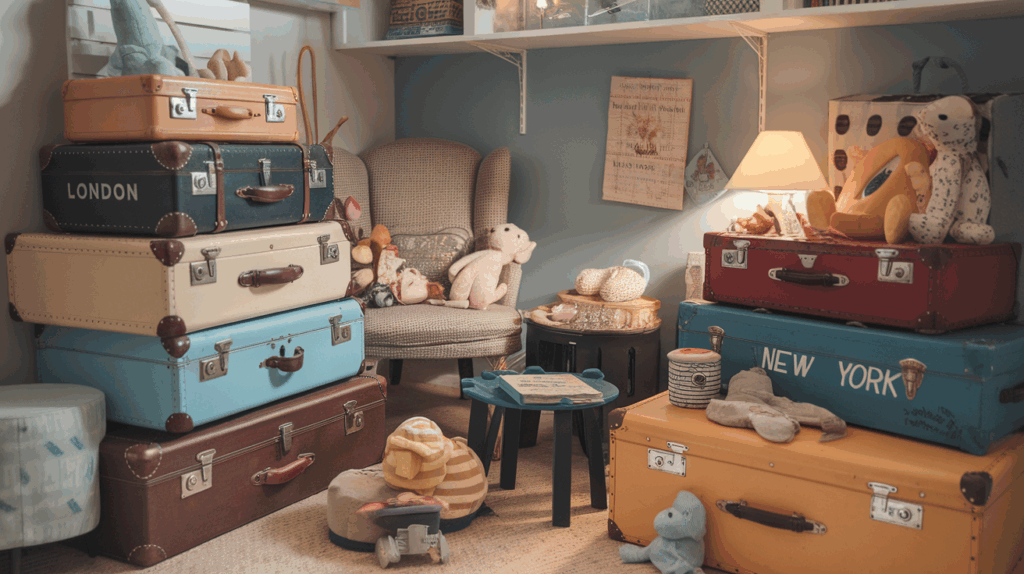
Repurposed suitcase storage is a stylish and eco-friendly way to store toys or art supplies. You can stack vintage suitcases or use them as a functional storage solution in corners or under furniture.
This repurposing idea helps keep the playroom tidy while adding a nostalgic charm to the space.
Repurposed suitcases are not only functional but can also be used as decorative accents, adding character and personality to the room.
42. Nature-Inspired Décor
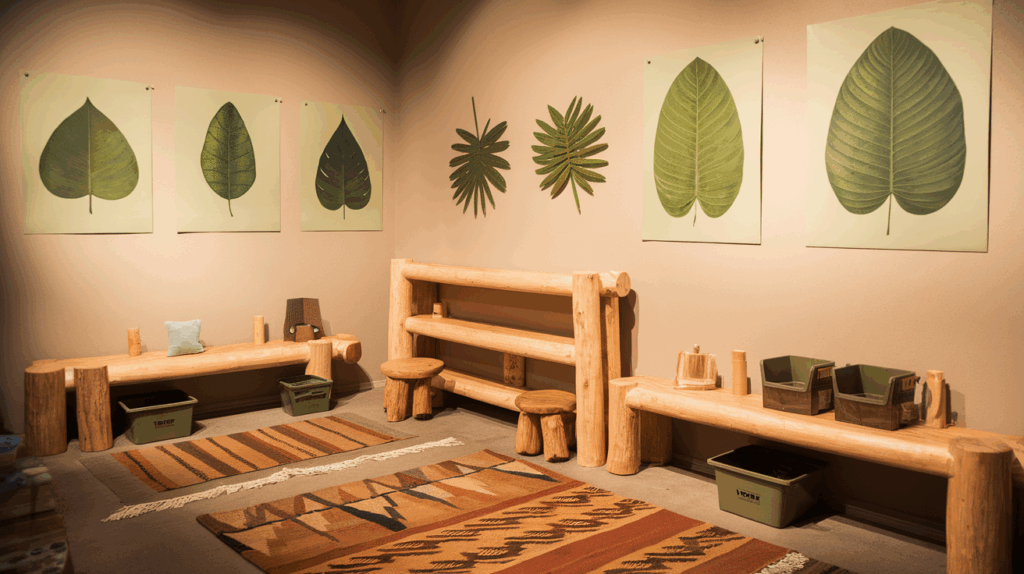
Nature-inspired décor, like plants or wood accents, brings a calming, natural feel to the playroom. It helps create a peaceful and organized space that promotes both creativity and relaxation.
If you add small indoor plants or natural textures, this approach ensures the room remains functional while still feeling warm and inviting.
Nature-inspired elements can also teach your child about the environment and help foster a sense of connection to the natural world.
43. Educational Wall Mural
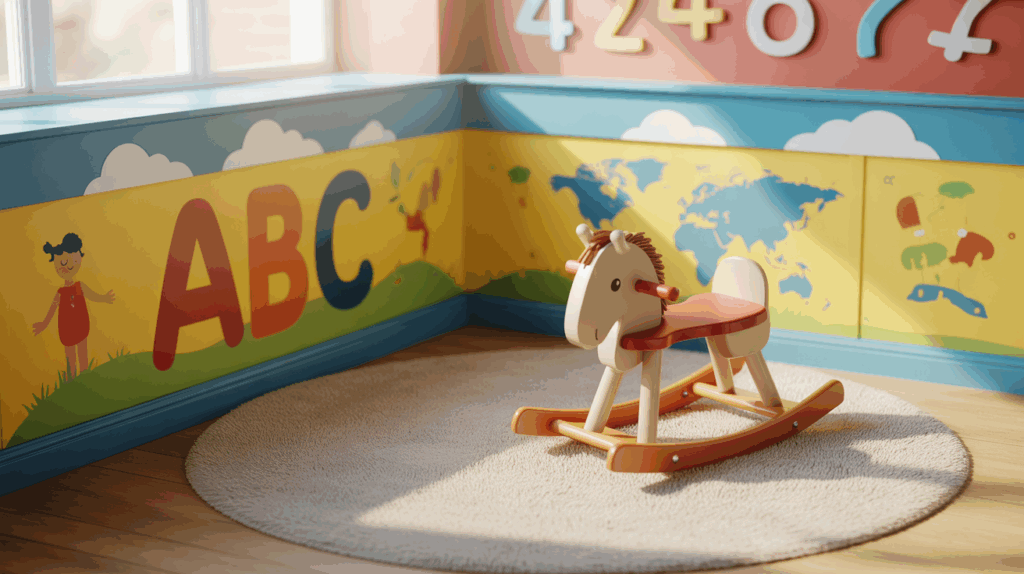
An educational wall mural adds both a decorative and learning element to your child’s playroom. It can feature maps, alphabets, numbers, or fun animals to spark your child’s curiosity.
This visual feature also serves as an educational tool, keeping the room organized while offering new learning opportunities.
By combining both functionality and art, an educational wall mural turns your playroom into an inspiring space where learning and creativity can thrive.
44. Soft Curtain Room Divider
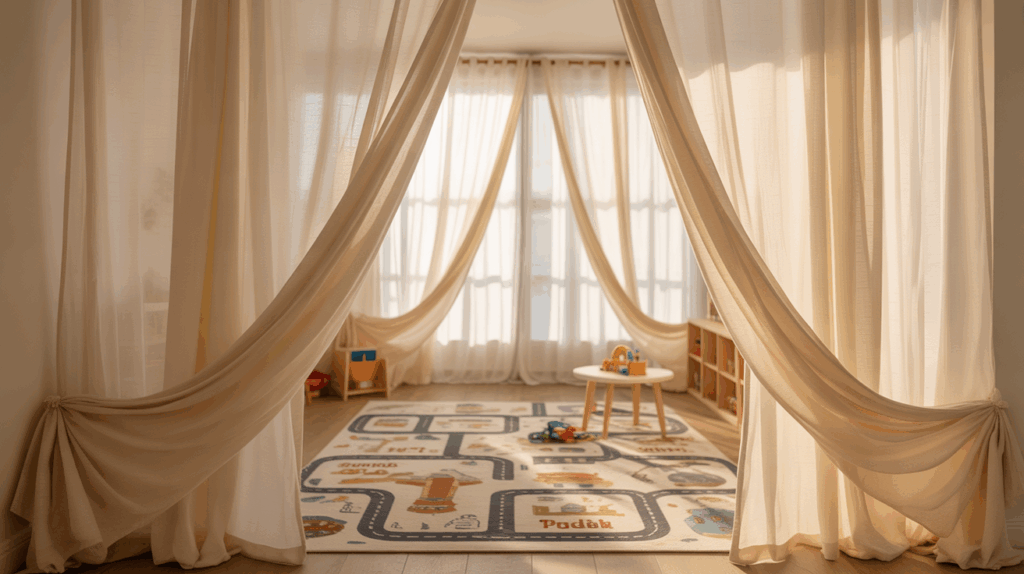
A soft curtain room divider allows you to separate the play area into distinct zones, helping to keep things organized.
It’s an easy-to-install solution that can be moved as needed, giving you the flexibility to create private spaces or play zones.
It’s perfect for rooms shared by multiple children or for creating a cozy, private nook. A curtain divider also adds a soft touch to the playroom, balancing practicality with style.
45. Seasonal Theme Swaps
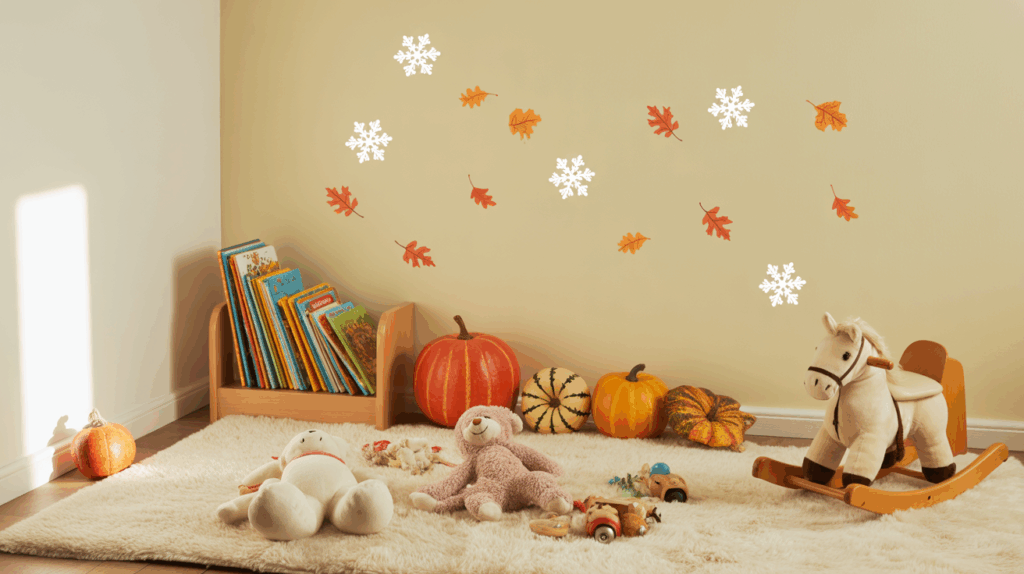
Seasonal theme swaps help refresh the playroom throughout the year without requiring major changes. You can switch out décor, toys, and accessories based on the season, keeping the room fun and organized.
This simple yet effective strategy helps maintain a tidy and dynamic space that feels new with every season.
Seasonal swaps keep the playroom engaging for your child, as they get to enjoy new decorations, colors, and activities in tune with the time of year.
46. Low, Child-Sized Shelves
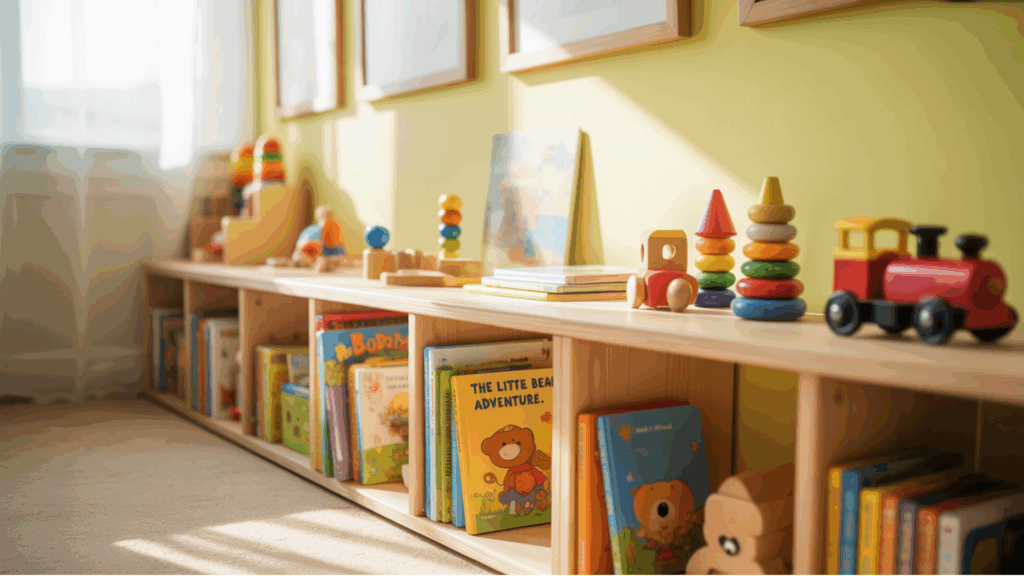
Low, child-sized shelves make it easy for your little one to access their favorite toys, books, and games independently. These shelves keep everything organized and visible, ensuring that the playroom stays clutter-free.
Plus, their easy accessibility encourages your child to put things back where they belong, fostering responsibility and organization.
Child-sized shelves also help teach organizational skills and encourage your child to keep their play area tidy.
What to Consider Before Setting Up a Small Playroom
Before organizing toys or buying storage, it’s important to plan the space thoughtfully. Consider the following:
- Natural Light: Identify where natural light enters the room.
- Play Preferences: Think about how your child likes to play (building, reading, etc.).
- Mess Zones: Identify areas that tend to stay messy and plan accordingly.
- Clear Walkways: Ensure walkways remain clear for easy movement.
- Safety: Anchor furniture, round edges, and use non-slip mats for safety.
- Create Zones: Divide the space into functional areas for reading, crafting, or building.
Planning with intention turns the playroom into a creative space without overwhelming your home.
Conclusion
You don’t need a large house or a dedicated room to give your child a great place to play.
I’ve seen how small playroom ideas like these turn tight spaces into creative, functional zones where kids can read, imagine, and explore safely.
By using smart furniture, vertical storage, and flexible layouts, you and I can make the most of every square foot.
These simple changes help keep things organized while still making room for fun.
Try a few of these ideas and watch how even a small space can become a big part of your child’s everyday joy.

